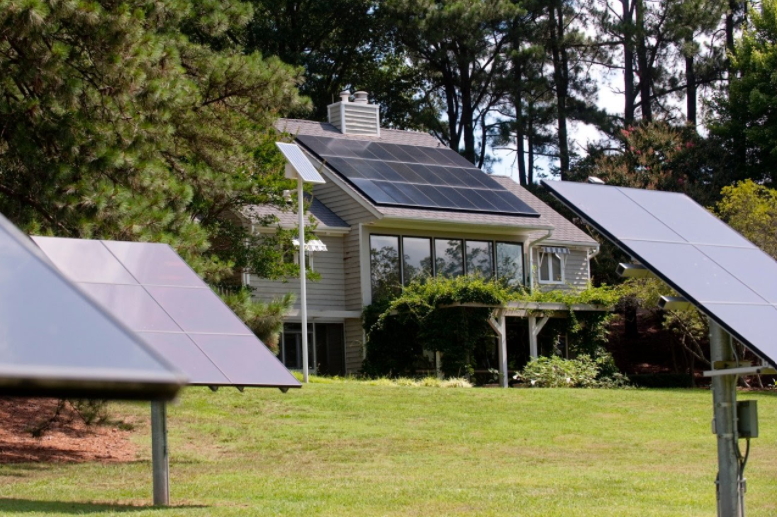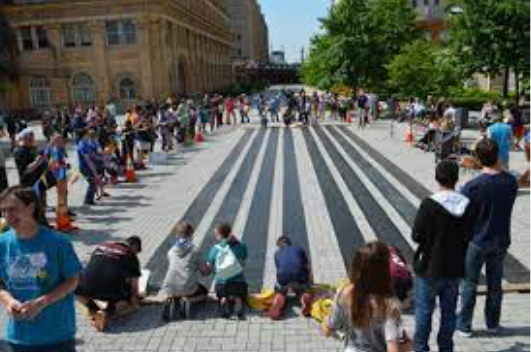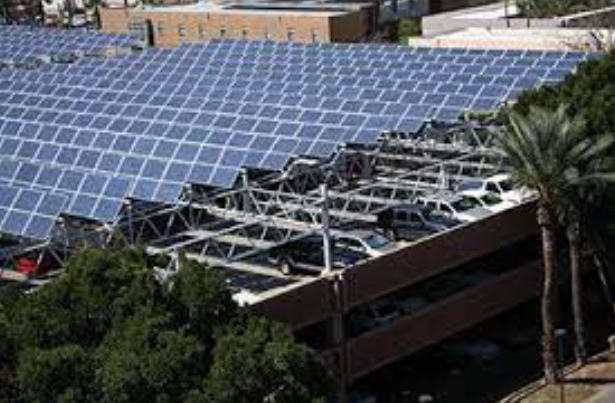Case Studies
In order to understand the ways we could involve the Kirby Solar Array within our Lafayette campus, we wanted to do further research on the ways solar energy affects general college campuses. To do this, we looked at multiple cases from different universities within the United States, and wanted to see how solar arrays and energy was involved within the community, curriculum, and policies of these schools. Lafayette College is inherently unique, and getting a better understanding of the current state of renewable energies on college campuses has helped us narrow down our plan to involve the Kirby Array further within our campus.
Many of the schools we looked at had highly ranked solar and renewable energy programs, as we wanted to get a broader understanding of how different schools work within the field. One of the universities that we looked at was the North Carolina State University, which has been a leading university relative to clean energy involvement and education. For the past 30 years, North Carolina State has involved students and the community within their clean energy efforts by implementing the N.C. Clean Energy Technology Center (See Figure 5). This center for renewable energies involves itself with partners from all different fields in order to teach its students a broader understanding of clean energy technologies. The Clean Energy Technology Center is acknowledged as a largely prominent center for clean energy education, and focuses its work around 7 categories: Renewable Energy, Clean Power & Industrial Efficiency, Clean Transportation, Training, Policy, Center Projects, and Energy & Sustainability Services (North Carolina State, 2021).

Figure 5: The NCSU Solar House, built by North Carolina Clean Energy and Technology Center at North Carolina State University. Used for demonstration, education, and research.
The NCCETC provides students with in person involvement with renewable energies, policy research and analysis, sustainability, and high level in-field training. The Center involves students directly within a technical setting to be able to demonstrate and educate students on clean energy technologies, practices, and policies. NCSU also holds many different solar energy projects, including a 16 foot large solar “tree”, which accumulates an output of around 2,114 kWh of electricity in one year (North Carolina State, 2021). In addition, the Center also provides leading research in solar energy, and is a massive resource for students and the public regarding governmental policies and incentives for clean energy. The NCCETC operates the Database of State Incentives for Renewables & Efficiency (DSIRE), which is “the most comprehensive source of information on incentives and policies that support renewables and energy efficiency at the federal, state, local, and utility levels. (North Carolina State, 2021)” The NCCETC provides large environmental and educational benefits to students at NCSU, and being open to students from any discipline the Center allows for deeper clean energy involvement within the curriculum, as well as offers internship opportunities, pushing it to be a leader in higher environmental education (North Carolina State, 2021).
Additionally, the NCCETC also provides support towards the sustainable energy economy throughout North Carolina by partnering with solar companies and creating shared solar projects. For example, the NCCETC created the Community Solar for the Southeast project. This project makes solar more affordable and accessible through shared solar projects developed by cooperative and municipal utilities across the Southeast. For this specific project, the Center partnered with multiple solar and utility stakeholders to determine solutions needed to increase development of community solar projects in the Southeast. This helps the project fully provide technical assistance to utilities across the Southeast in order to help them analyze, design, and implement community based solar projects. The project was awarded a million dollars from the SunShot initiatives, a solar energy based government program to incentivize and promote solar adoption. This resulted in the project adding an additional 200 megawatts or more of community solar projects in the Southeast, which is a massive change from the 1 megawatt output that currently exists. The project also entails the publishing of a guide to implementing community based solar projects, which will provide a framework for all utilities in the region that are not touched by this project to also increase shared solar projects. The NCCETC thoroughly involves itself within its community and aims to not only be a resource for the school, but also provide renewable energy services, education, and support to the surrounding area. North Carolina State’s Center stands as a great example of how renewable energies can involve themselves with a university and its community, and there is a lot we can learn from from their programs.
Another school with promising developments around their solar energy program is Drexel University. With Drexel located in close proximity to campus, this peer school can serve as an example as to how Lafayette can involve the community with solar array. Drexel committed in 2010 to have “100 percent clean renewable wind and solar energy (Drexel University, 2010).” This commitment was funded through the purchasing of Renewable Energy Certificates or RECs which “are a market-based instrument that certifies the bearer owns one megawatt-hour (MWh) of electricity generated from a renewable energy resource. Once the power provider has fed the energy into the grid, the REC received can then be sold on the open market as an energy commodity (Chen, 2021).” Through these renewable energy credits Drexel not only expanded their solar energy production but also generated community and student body initiatives around their new solar energy production.
One development that came from this was increased funding towards solar research in which undergraduate and graduate students worked on solar power research projects. Some of the recent developments of this research has been students working on the development of thin film solar cells (Drexel University, 2010) as well as research on various dyes that can be used to help solar panels become more efficient (Drexel University, 2012). Aside from research the school has also promoted a new minor in green energy and sustainability. In this coursework students can take courses such as solar energy engineering, energy conversion, as well as renewable energy systems (Drexel University, n.d.). Through this program and other integrated renewable energy coursework on campus students are able to study and work with the solar panels that have been constructed.
In addition to the increased student involvement around solar energy, the college also offers community initiatives that allow for renewable energy centered interactions between the University and the surrounding community. One of the oldest initiatives Drexel has is the Junior Solar Sprint (See Figure 6). The event, in which Drexel partners with Philadelphia Solar Energy Association to put on, consists of students from 5th through 8th grade coming to the campus to compete in a competition to see who can design the best solar powered car. While the event is designed to “develop students hands-on experience in science, technology engineering, and math (Drexel University, n.d.)” It also exposes them to the possibilities of designing using sustainable technology, something that is often overlooked in domestic science education.

Figure 6: Drexel University “Solar Sprint” Competition
Along with the development of programs for local youth, Drexel has also set out to make the cost of solar installations more affordable for local families. According to their plan, Drexel “works with a solar company to provide free energy usage assessments on community members’ homes. After the assessment, Drexel provides discounts and rebates to these homeowners, helping them to reduce the cost of solar array installation (Solar Power Authority, 2019).” Through this initiative Drexel is not only making solar power more accessible but also strengthening its ties with its communities.
One of the largest adopters of solar power amongst universities in the U.S. is Arizona State University. As of June 2021 they had a combined on-site solar power output of 24.2 MW, and a total output of 53 MW. With a carbon offset of over 42,000 metric tons (Arizona State University, n.d.)ASU has shown their continued commitment to their investment in large scale solar arrays across their campus. In support of their continued efforts, ASU cites a multitude of practical benefits from their solar arrays. Aside from the obvious electricity generation their arrays provide nearly 6,000 shaded parking spaces, reduced building heat-load, and extended lifetime for roofs that have solar arrays installed (Figure 7).
These are common benefits to the adoption of solar power on college campuses. However, like many other Universities, ASU has embraced the various educational and community engagement benefits that can come from their solar arrays as well. They have used their arrays to build living-learning laboratories to provide lab experience for students at the Julie Ann Wrigley School of Sustainability. And by providing access to some of their solar arrays they have been able to construct a solar lab and deck that gives students the opportunity to research solar energy uses, new PV modules, and new solar energy technology. The classroom and lab opportunities have allowed ASU to become a leading institution in Solar Energy Technology research, development, and training. They have since introduced a Solar Energy and Commercialization graduate program which has allowed ASU to create strong industry connections and create a groundbreaking interdisciplinary solar education program and made them an industry leader in solar education.
ASU didn’t stop there, they even utilized their solar energy prowess to create charity programs. ASU’s SolarSPELL program uses solar power digital libraries to help bring teaching tools and basic literacy skills to underserved communities around the world (Arizona State University, n.d.). Not only does this give ASU the chance to use their solar power capabilities to give back, but it can help to improve global views of solar energy and provide even more learning and teaching opportunities to students, volunteers, and faculty. This type of community engagement is an important part of using solar energy to improve its public appearance and increase adoption. ASU first began their implementation of solar arrays on campus in 2004, and at Lafayette we can use their extensive experience to help inspire and develop our own education and community engagement opportunities with the Kirby solar array right here in Easton.

Figure 7: Solar Parking Structure at Arizona State University
Click Here To Read Our Next Section: Social Context